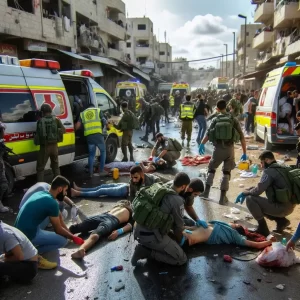Israel and Palestine have a long and complicated history that has led to a prolonged and often violent conflict between the two groups. The conflict dates back to the late 19th century with the first Zionist settlements in Palestine, under the Ottoman Empire. Later, the British controlled the region. They made conflicting promises to Jews and Arabs about the future of the land. In 1947, the United Nations proposed partitioning the territory into separate Jewish and Arab states. Arab nations rejected this plan, leading to a war where Israel secured a larger portion of the land. This conflict displaced hundreds of thousands of Palestinians, forcing them to flee their homes and creating a persistent refugee problem. The conflict has continued to this day, with periodic outbreaks of violence and failed attempts at peace.
Contents
Current Situation in Gaza
The current situation in Gaza is dire, with a significant humanitarian crisis unfolding due to the ongoing conflict. The region is facing critical shortages of basic necessities like fuel, food, medication, water, and essential medical supplies.The blockade imposed on the Gaza Strip exacerbates the already precarious living conditions in the region. Ongoing violence has displaced many people, worsening the existing refugee problem. Calls for a ceasefire and negotiations to end the conflict have been frequent, but a lasting solution remains elusive. The situation remains volatile and the humanitarian crisis continues to deepen, highlighting the urgent need for a peaceful resolution to the conflict.
Israel and Palestine: International and Political Reactions

The Israel-Palestine conflict has garnered significant international attention, with many countries and political leaders weighing in on the situation. Many have called for a ceasefire and de-escalation of the violence, including the United States, United Nations, European Union, and several Arab countries. Some student organizations, charities, and religious groups have also expressed their views and concerns about the conflict. Public opinion remains divided. A recent survey shows that a majority of Americans blame Hamas for the conflict, while others criticize Israel’s response as disproportionate. Many have welcomed the recent truce between Israel and Hamas, hoping it leads to a longer-term ceasefire and the release of prisoners on both sides. The international community acknowledges the urgency of resolving the conflict peacefully and actively engages in efforts to bring the parties to the negotiating table.
Israel and Palestine: Analysis of Military and Political Strategies
The military situation in the Israel-Palestine conflict is complex. Both sides use different strategies to assert their claims. Israel has a significant military edge, boasting a well-trained, equipped army, advanced technology, and defense systems. Conversely, Hamas employs guerrilla tactics, using homemade rockets and other improvised weapons against Israeli cities and towns. Politically, Israel seeks to control disputed territories. Hamas aims to end Israeli occupation and establish a Palestinian state. Yet, neither has achieved decisive victory, resulting in a prolonged conflict with sporadic violence. The recent ceasefire brings hope. However, lasting peace depends on a political solution addressing the conflict’s root causes.

The local population has faced severe humanitarian impacts from the conflict, primarily affecting civilians. Thousands of Palestinians have been displaced, taking shelter in UN-run schools and other safe havens. There are numerous reports of civilian casualties, including women and children, and significant damage to civilian infrastructure such as hospitals and schools. The blockade of Gaza has worsened the crisis, causing shortages of food, medicine, and other essentials.
The conflict’s psychological toll is profound, causing trauma and PTSD for many. A woman shared her constant fear of airstrikes: ‘We live in a state of terror and anxiety. We don’t know when the next bombing will happen or where it will hit.’ Such personal stories underscore the urgent need for peace and more humanitarian aid.
Regional and International Diplomacy
The Israel-Palestine conflict remains a critical issue in international relations, drawing efforts from various regional and global actors to resolve it. Egypt recently brokered a ceasefire between Israel and Hamas to halt the violence and save lives. Simultaneously, countries like the United States have engaged in diplomatic efforts to convene negotiations. The United Nations, too, has been involved, with the Secretary-General advocating for an immediate ceasefire and the UN Security Council conducting emergency discussions.
However, achieving a lasting solution is challenging due to deep-rooted mistrust and complex issues. The recent ceasefire offers a potential starting point for more thorough negotiations, but the path to enduring peace is arduous. It demands sustained diplomatic engagement and compromises from all involved parties.
Perspectives on the Outcome of the Conflict
The potential outcomes of the Israel-Palestine conflict are widely debated, with different perspectives on what a resolution might look like. Some advocate for a two-state solution, with the creation of an independent Palestinian state alongside Israel. Others support a one-state solution, with Israelis and Palestinians living together in a single democratic state. Significant challenges hinder these proposals. These include disagreements over Palestinian state borders, Jerusalem’s status, and Palestinian refugees’ right of return. Fears persist that the conflict might continue with cycles of violence and repression. Yet, some remain optimistic about a peaceful resolution. Ultimately, the conflict’s outcome hinges on both parties’ willingness to negotiate in good faith and compromise for lasting peace.
Conclusion
The Israel-Palestine conflict is a complex and multifaceted issue that has eluded a peaceful resolution for decades. The recent ceasefire offers hope, but lasting peace needs ongoing diplomacy, compromise, and a commitment to end violence. The international community must support just and lasting peace efforts. It’s crucial to listen to and consider the voices of those most affected by the conflict. Building a brighter future for all impacted by this long-standing conflict requires dialogue, understanding, and a search for common ground.
References
- The Israel-Palestine Conflict: One Hundred Years of War by James L. Gelvin
- The Palestinian-Israeli Conflict: A Very Short Introduction by Martin Bunton
- “The Israel-Palestine Conflict: A Beginner’s Guide” by BBC News (https://www.bbc.com/news/world-middle-east-29123668)
- “A History of the Israeli-Palestinian Conflict” by the Council on Foreign Relations (https://www.cfr.org/backgrounder/history-israeli-palestinian-conflict)
- “The Gaza Strip: An Explainer” by The Washington Post (https://www.washingtonpost.com/news/worldviews/wp/2018/05/14/the-gaza-strip-an-explainer/)



